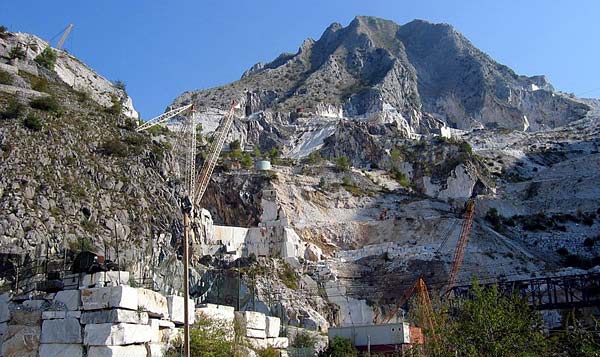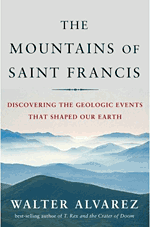 The fabled marble quarries of Carrara, which supplied Michaelangelo with the stone blocks he transformed into enduring masterpieces, contribute uniquely to the geological potpourri that is Italy.
The fabled marble quarries of Carrara, which supplied Michaelangelo with the stone blocks he transformed into enduring masterpieces, contribute uniquely to the geological potpourri that is Italy. What makes rocks so wonderful?
Walter Alvarez's new book, on the complex and highly varied geology of Italy's mountains, is a personal tale based on years of exploration and discovery
| 05 February 2009
BERKELEY — Italy's mountains, from the Apennines to the Alps, have fascinated geologist Walter Alvarez for more than 35 years, resulting in a new book, The Mountains of Saint Francis, that traces Italy's billion-year geologic history with a focus on Italian geologists and their groundbreaking — and often overlooked — discoveries.
In the book, published in December by W. W. Norton, Alvarez, a Berkeley professor of earth and planetary science, takes readers on a tour of road cuts and quarries — and even a wine cellar — to sketch this history, weaving in affectionate portraits of the geologists Alvarez and his wife, Milly, have met since first visiting Italy in 1968.
"I thought it would be fun to write a book that had a lot of human interest in it as well as geology," Alvarez says. "Much as I like the science, I like my science mixed with culture and people and friendships and language."
Alvarez is the author of the acclaimed T. rex and the Crater of Doom (Princeton University Press, 1997), about his discovery with his father, Nobel laureate Luis Alvarez, of a long-ago comet collision with Earth that coincided with the demise of the dinosaurs.
 His new book revisits the site in Gubbio where he first discovered evidence, preserved in a layer of rock, that something catastrophic had occurred 65 million years ago at the boundary between the Cretaceous and Tertiary periods, when dinosaurs and many other creatures died out. But Alvarez also takes readers along the Apennine spine of Italy from Rome to Florence, jumping from there to the Alps, to explain how the Italian peninsula came to be. He refers to the Umbria-Marche Apennines as the Mountains of Saint Francis because of the many reminders of St. Francis of Assisi throughout the mountain range.
His new book revisits the site in Gubbio where he first discovered evidence, preserved in a layer of rock, that something catastrophic had occurred 65 million years ago at the boundary between the Cretaceous and Tertiary periods, when dinosaurs and many other creatures died out. But Alvarez also takes readers along the Apennine spine of Italy from Rome to Florence, jumping from there to the Alps, to explain how the Italian peninsula came to be. He refers to the Umbria-Marche Apennines as the Mountains of Saint Francis because of the many reminders of St. Francis of Assisi throughout the mountain range.
"If you spend time in that part of Italy, you are constantly coming face to face with the heritage and influence of St. Francis," he says.
Deep rocks
Alvarez also takes the opportunity to highlight the groundbreaking work of Italian geologists, often neglected in America in favor of their English-speaking counterparts. During his early career, Alvarez was one of the few Italian-speaking Americans working on the geology of Italy.
"I hope this book will serve geologists as an antidote to an Anglophone viewpoint that ignores many of our worthy scientific forebears from other countries," he wrote.
A puzzle still in progress
Even the casual observer can't help but be amazed by the unique geology of Italy.
"Italy has a highly varied landscape: old volcanoes around Rome and Naples; mountains made of limestone in the Apennines, and, over near Pisa, a mountain made of pure white marble, the marble Michelangelo used for his statuary," Alvarez says. "And up in the Alps, there are great peaks of granite and metamorphic rocks and dolomite. Mountains made of sandstone and a huge volcano in Sicily at Etna. The island of Sardinia is largely made out of granite. There are other places that have an equal variety of geology, but I can't think of any that have more variety."
Starting with more recent geologic history — eruptions along a volcanic chain north of Rome over the past million years — Alvarez then takes readers back 100 million years to a time when much of Italy was an ocean floor, before it was pushed above sea level and crinkled into the rows of mountains known as the Apennines. The layered ocean-floor sediments are now visible as limestone and sandstone across the entire Apennines, folded and overthrown as the mountains were thrust up and then eroded to create a puzzle still being pieced together.
"The beautiful thing about these rocks in Italy was they were too deep to be affected by waves and storms, so they just had the most wonderful record of Earth history that you could imagine," he says.
Much of this geologic history is visible in Alvarez's favorite haunts — the quarries sprinkled throughout Italy. The quarried limestone has been used to build Italian cities since the time of ancient Rome.
"If you travel around in Italy and look at the buildings, you will see that the Italians just love ornamental stone," Alvarez says. "Even if you wander around San Francisco and look at the storefronts, you will see limestone and marble from all over Italy, as well as granites and schists."
Colliding with Adria
Alvarez's own research, in particular the work in collaboration with Bill Lowrie using magnetic signatures left in sediments to date rocks, has helped reconstruct some of this Italian history.
After the Apennines appeared about 40 million years ago, in the Eocene, the continental plate known as Adria, which carried the mountain chain, collided with the European continent, shoving an even more ancient sea floor several miles up to form the Alps. Alvarez's research has helped validate the theory behind this — plate tectonics — which holds that the surface of the Earth is covered by a jigsaw puzzle of continental and oceanic plates that move around, generating mountains where they collide.
Alvarez acknowledges that most people overlook rocks in favor of ever-changing trees, flowers, and wildlife, but the unchanging nature of rocks is what drew him into geology.
"What makes rocks so wonderful is the fact that they barely change at all, and as a result, they … preserve the way they formed, whether a million years ago or a thousand million years ago," he says. "We simply wouldn't know anything about what happened beyond human memory or writing if it wasn't for having things recorded in rocks. They are history books, and quarries are like libraries."
Raised in Berkeley, Alvarez earned his Ph.D. from Princeton University in 1967, worked for oil companies in the Netherlands and Libya, applied his geological knowledge to uncovering the archeology of ancient Rome, and later worked at the Lamont-Doherty Earth Observatory in New York before landing at Berkeley in 1977. While he has studied the mountain belts of Central Asia and the Colorado Plateau, he inevitably returns to Italy, especially the Apennines.
"I always knew that some day I wanted to write a book about the Apennines, and it just simply took a long time to learn enough about the mountains. Geologists didn't understand the mountain range well enough either, so I couldn't have written the book in the '70s or '80s or probably even the '90s," he says. "There is a lot we don't yet understand, but the story has come together enough that I thought I could tell a reasonable geological story."
Still curious about the geology of Italy, he currently is working with graduate student David Shimabukuro to determine the relationship between the island of Sardinia and Calabria, the toe of the Italian boot, which has moved southeastward over the millennia to open up the Tyrrhenian Sea.
Just as his book displays a deep interest in the connection between human and geologic history, he has developed a course at Berkeley called Big History, which explores the commonalities in the evolution of the cosmos, Earth, life, and humanity and the chance events underlying historical change.
"It is fun to think about contingency in history," he says, that is, when some unforeseen event—a comet impact, for example—comes along and "completely derails things so that tomorrow's history is nothing at all like last year. I think I can make a contribution here because of my work on the impact that did in the dinosaurs, which ... was an outrageously unlikely event that, had it not occurred, the dinosaurs would still be around and there wouldn't have been any human beings."

